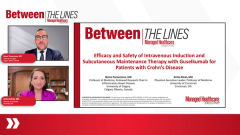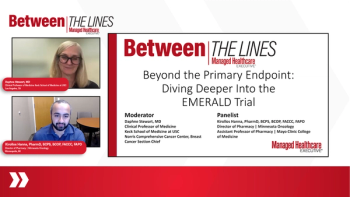
Key Data and Clinical Takeaways From GALAXI-2 and GALAXI-3 Trial Results
Panelists discuss how the GALAXI trial results demonstrated guselkumab’s durability, efficacy, rapid onset and clean safety profile with superiority over ustekinumab across most objective end points, including endoscopic response and deep remission. The clinical and endoscopic end points align with STRIDE-2 treatment targets and translate to meaningful patient outcomes, including symptom resolution and reduced future hospitalizations, surgeries and disease flares.
Episodes in this series

Key Data and Clinical Takeaways from GALAXI-2 and GALAXI-3
Primary Efficacy Outcomes and Clinical Impact
The GALAXI-2 and GALAXI-3 trials demonstrated highly positive results, with guselkumab showing substantial efficacy across multiple clinical parameters. Key clinical takeaways include demonstrated durability, efficacy, rapid onset of action and an excellent safety profile. The treat-through design enabled comprehensive assessment of short-term and long-term outcomes, with meaningful results observed at week 12 and week 48 timepoints. Importantly, efficacy was demonstrated across patient populations regardless of prior biologic exposure, showing good response rates in biologic-naive and biologic-experienced cohorts. The composite end points incorporating clinical and endoscopic measures provided robust evidence of therapeutic benefit that aligns with current treatment paradigms and STRIDE-II recommendations.
Comparative Efficacy and Dosing Flexibility
Direct head-to-head comparison with ustekinumab revealed guselkumab’s superiority across most objective and composite end points, including endoscopic response, endoscopic remission and deep remission (composite of clinical and endoscopic remission). Two maintenance dosing regimens were studied: 100 mg subcutaneous every eight weeks and 200 mg subcutaneous every four weeks, with both doses demonstrating superiority over placebo for clinical and endoscopic end points. This dosing flexibility provides clinicians with therapeutic options, as the 200-mg dose delivers approximately sevenfold more drug exposure, potentially allowing for individualized treatment approaches. The superiority over ustekinumab, a widely used therapy in clinical practice, represents a particularly powerful clinical message supporting guselkumab’s therapeutic positioning.
End Point Significance and STRIDE-II Alignment
The trial end points were strategically designed to align with STRIDE-II treat-to-target recommendations, encompassing short-term clinical targets (patient-reported outcomes), intermediate targets (biomarker improvement) and long-term targets (endoscopic assessment). Clinical end points are particularly meaningful to patients as they directly impact daily quality of life through symptom resolution. Endoscopic end points carry significant prognostic value, as achieving these targets is associated with decreased hospitalizations, reduced surgical interventions, decreased corticosteroid dependence, and fewer disease flares in the future. The comprehensive end point framework ensures alignment with evidence-based disease monitoring strategies and supports the goal of identifying optimal treatment for individual patients while confirming therapeutic appropriateness through objective measures.
Newsletter
Get the latest industry news, event updates, and more from Managed healthcare Executive.




















































